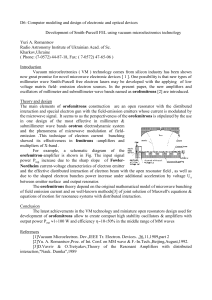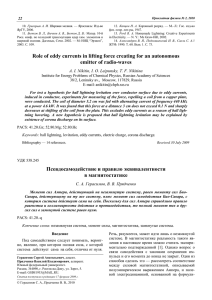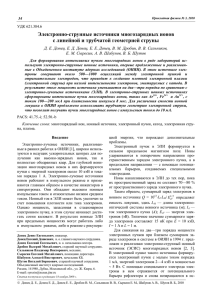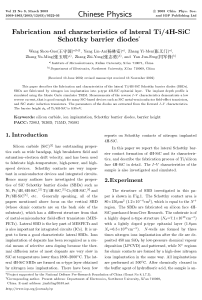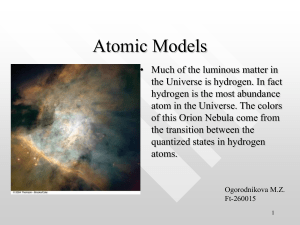
Electrontrap generation by recombination of electrons and holes in SiO2 I. C. Chen, S. Holland, and C. Hu Citation: J. Appl. Phys. 61, 4544 (1987); doi: 10.1063/1.338388 View online: http://dx.doi.org/10.1063/1.338388 View Table of Contents: http://jap.aip.org/resource/1/JAPIAU/v61/i9 Published by the American Institute of Physics. Related Articles Exciton confinement and trapping dynamics in double-graded-bandgap quantum nanowires Appl. Phys. Lett. 100, 211907 (2012) Fluctuation of mean free path and transition temperature induced vortex pinning in (Ba,K)Fe2As2 superconductors Appl. Phys. Lett. 100, 212601 (2012) Modeling of carrier lifetimes in uniaxially strained GaAs J. Appl. Phys. 111, 103704 (2012) Electrical transport and optical model of GaAs-AlInP core-shell nanowires J. Appl. Phys. 111, 094319 (2012) Photocarrier radiometry of ion-implanted and thermally annealed silicon wafers with multiple-wavelength excitations J. Appl. Phys. 111, 093729 (2012) Additional information on J. Appl. Phys. Journal Homepage: http://jap.aip.org/ Journal Information: http://jap.aip.org/about/about_the_journal Top downloads: http://jap.aip.org/features/most_downloaded Information for Authors: http://jap.aip.org/authors Downloaded 02 Jun 2012 to 140.254.87.101. Redistribution subject to AIP license or copyright; see http://jap.aip.org/about/rights_and_permissions Electron..trap generation by recombination of electrons and holes in Si0 2 !. C. Chen, S. Hoiland, and C. Hu Department 0/ Electrical Engineering and Computer Sciences, University of California, Berkeley, California 94720 (Received 6 November 1986; accepted for pUblication 30 December 1986) It is shown that after holes are injected and trapped in silicon dioxide (SiO z ), subsequent electron injection will generate neutral electron traps. The density of electron traps generated is about 30% of the density of trapped holes. It is proposed that electron traps are created by the energy released through the recombination of electrons and holes, and that this is the mechanism of electron-trap generation during high-field oxide stressing. Similar oxide field and thickness dependencies of the rate of electron-trap generation and hole generation further support this model. This model can reconcile the main evidence for the electron-trapping oxide breakdown model with the hole-trapping breakdown model. It is consistent with the higher trap generation rate in irradiated Si02 • An analytical trapping model is derived and the electron capture cross sections of trapped holes and the generated neutral traps art-found to be 10- 14 cm 2 and 5 X 10.- 16 cm 2, respectively. I. INTRODUCTION Silicon dioxide time-dependent breakdown is widely believed to be associated with charge trapping in the oxide. It is known that during a high-fie1d!current stress both electron trapping and hole trapping take place in the oxide. Breakdown has often been attributed to the positive feedback effect induced by hole trapping with holes created by energetic electrons through impact ionization.'-3 Recently, we have presented results pointing to hole generation and trapping as the cause of breakdown without committing to band-toband impact ionization as the mechanism of hole generation.4-7 This may be referred to as the hole-trapping oxide breakdown model. Among the evidences are a similar field dependence of charge to breakdown, QnD' and the hole generation coefficient a (Ref. 4), a nearly constant substrate hole nuence at breakdown, 5 correlation between the rate of process-induced hole trapping and QSD (Ref. 6), and the effects of polarity and thermal annealing. 7 Harari, K however, proposed that the increase of the electric field near the anode due to electron trapping leads to Si-O bond rupture and causes breakdown. This may be referred to as the electrontrapping breakdown model. The main support for this model is that the gate-voltage increase (t:. Vg ) before breakdown in a constant current stressing experiment is a constant independent of the stressing current density and ambient temperature. This electron-trapping breakdown model has also been accepted by others. 9 On the other hand, DiMaria!O has shown that introducing electron traps into Si02 actually has increased oxide lifetime. This directly contradicts the electron-trapping breakdown model. In our experiments we have found no link between electron trapping and break- ' down except for the constancy in A Vg before breakdown. One wonders why electron-trap generation correlates so wen with oxide breakdown. With regard to electron-trap generation, the underlying physical mechanism is unknown. Jeng et af. reported an increase in the trap generation rate with oxide field. 11 Liang et al. observed that the trap generation rate has a power-law dependence on stressing current density. 12 An oxide thick4544 J. AppL Phys. 61 (9). i May 1987 ness dependence of the trap generation rate has also been noted. 13 Badihi et at. observed that both high field and current are necessary to create electron traps and that the generated electron-trap density was proportional to fluence and nearly exponentially dependent on oxide field. 14 Heyns et al. have also reported trap generation under high-field/current stress. 15,16 The centroid of the generated traps was found to be close to the anode interface. 16 Curiously, very similar observations with regard to field, current, and thickness dependencies and centroid have been made for hole generation and trapping. 4 .5 In this paper, a recombination-induced electron-trap generation model is proposed. This simplifies the model of charge trapping and trap generation and explains many observations involving charge trapping, radiation effect, and oxide breakdown. II. SAMPLE PREPARATION Both p-channel and n-channel large-area silicon gate metaI-oxide-semiconductor field-effect transistors (MOSFET) were used in this study. The starting Si wafers were (100) oriented with a substrate phosphorus (boron) doping of approximately 6X lOl6 cm -3 (1 X 10 15 cm- 3 ) forp-channel (n-channel) devices. The gate oxide was grown in dry oxygen at 900 ·C, followed by a 20-min N2 anneal at the same temperature. In situ phosphorus-doped polycrystalline silicon was then deposited at 650 ·C. After gate definition, the wafers were annealed at 9OO·C for 20 min. Boron (arsenic) was then implanted into the source/drain regions of the p-channe1 (n-channel) devices and was driven in at 925 ·C for 75 min in an oxidizing ambient. After aluminum deposition and definition, the wafers were sintered in forming gas at 425 ·C for 20 min. III. EXPERIMENTAL RESULT In order to study the role of trapped holes in the process of electron-trap generation, substrate hot-hole injection in a p-channe1 device was employed to inject holes into the oxide 0021-8979/87/094544-05$02.40 @) 1987 American Institute of PhySiCS Downloaded 02 Jun 2012 to 140.254.87.101. Redistribution subject to AIP license or copyright; see http://jap.aip.org/about/rights_and_permissions 4544 15 ~ , (. '! I • T•• ~ 1I0! 12 9 u 7.8 ",.-.-,.....,..,-.......-.-~-.-r-r....,.....,.-r--.-..-..-r.,...,......,....,.., W/L = 100/30 um [Clem!!] 1) 3:<ID'" .~ 2) [,,10.4 -.-~ I' 2' 3) 3,.,10" -~ 3' 4) 1>:10" -~ 4' Tox == 90A l' Jg:::: 10- 4 A/cm 2 7.7 6 O,Fresh 7.4 F (a) 0-73~~~~_~2~~~~_~1~~~~O~~~~ Vg (c) 7.3 bF.'-b~.~I~'~~~'~!~'~'~'~'-LI~.~~b'~!~,~,~,~,~ o 20 40 60 80 100 t (volt) Tax == 90A Vg == 6.3 V j [sec] 0.3 0.2 1 0.1 (d) (b) 10~~~~~~~~~~~~~----~ o 20 40 60 t [sec] 80 100 0.2 0.4 0.6 ~ 0.8 FIG. L (a) High·frequency C-V characteristics for a fresh device and devices with variQus amounts of substrate hot-hole injection (curve." 1-4). The negative shifts of the C·V curves relative to the fresh one indicate the amount of trapped holes. These devices are then subject to a constant Fowler-Nordheim current (Jg = 10- 4 ) stressing, as shown in Fig. l(c), and the C-V measurements afterwards are the curves labeled 1'. (b) Constant-voltage stressing (Eox = + 7 MVI cm) for the fresh sample and the samples with injected holes shown in Fig. 1(a}. The reference curve is taken from a fresh device (without injected holes). The initial higher current for curves 1-4 compared to the reference curve is due to trapped holes, while the eventual lower current is believed due to electron-trap generation. (c} Constant current stressing (Jg = 10- 4 A/cm 2 ) to the devices, both fresh and with injected holes, shown in Fig. 1(a). The voltage differences between the saturation levels of hole-injected devices and the reference level are proportional to the electron traps generated. The C-V measurements after this stressing are shown in Fig. 1 (a) (curves 1--4). (d) TIle positive flat-band shift shown in Fig. I (a), indicating the amount of electron traps gene1ated, plotted against the corresponding negative shifts shown in Fig. 1 (a), indicating the amount of trapped holes. The slope between the data points, - 30%, is the conversion efficiency from the trapped holes to the generated electron traps, assuming the centroids for the two charges are the same. at relatively low oxide fields (Eox::::: - 1 MV/ern).17 Because ofthe low gate field, electron injection or generation is negligible. High substrate bias (Vsub = + 17 V) is necessary to have a reasonable hole injection current. Capacitance-voltage (C- V) curves were measured after the hole injection to determine the amount of trapped holes. Figure 1 (a) shows the I-MHz high-frequency C-V curves before (fresh) and after various amounts of hole injection (curves 1-4), measured. by integrating the gate current. Then, electrons were injected into the Si02 via Fowler-Nordheim (F~ N) tunneling at a constant voltage (or current). From the changes in the gate current (voltage), the trapped electron densities in the oxides can be determined. The current as a function of time under constant-voltage stress is shown in Fig. 1(b). Because of the trapped holes, the initial current densities for curves 1-4 are higher than that of a fresh device (reference curve), as expected. Ifthere are no excess generated electron traps in samples 1-4, curves 1--4 should eventually merge with the reference curve or stay above it. How4545 J. Appl. Physo, Vol. 61, Noo 9, i May 1987 ever, as shown in Fig. l(b), curves 1-4 actually fall below the reference curve, indicating that additional electron traps are generated and fined. In addition, the number of electron traps generated increases with the number of trapped holes. In order to determine the densities of generated electron traps, a similar experiment was performed, as shown in Fig. 1(c). In this experiment, a constant current (Jg = 10- 4 A/cml) was applied after hole injection. For each device with trapped holes, the gate-voltage variation with time shows an initial rise and saturates shortly afterward. The difference between the saturated voltage level and that of a fresh device (without injected holes) is an indication of the excess electron traps generated, which is also evidenced by the positive shift in the C- V measurement after the constant current stressing, as shown in Fig. 1 (a) (curves 1'4'). Figure 1(d) shows the relationship between trapped hole density and generated electron-trap density, represented by the negative flat-band shift after hole injection (curves 1-4 in Fig, 1 (a)] and the positive flat-band shift after the Chen, Holland, and Hu Downloaded 02 Jun 2012 to 140.254.87.101. Redistribution subject to AIP license or copyright; see http://jap.aip.org/about/rights_and_permissions 4545 r ~ "0 Q.) +' cd ....(l) ~ 0,.) b.V Cfl 0.. ~ f.< Q.) ..... ..... CI.) b.V Q) 10-9 154A~~ 62:~~ cd P, 0,.) 0.. 6 l 8 l/Eox (*1 0-8)( em/V) 10 subsequent electron injection [curves 1'-4' in Fig. 1 (a) ], respectively. The ratio of the generated electron-trap density to the trapped hole density suggests that about 30% of the trapped holes lead to the creation of electron traps, One plausible explanation for the correlation between trapped holes and electron traps is recombination-induced trap generation. 18.19 The energy released by recombination of an electron and a trapped hole could break a molecular bond and the bond relaxes to a different state, creating a neutral electron trap. The 30% efficiency mentioned earlier may be due to hole detrapping or other competing mechanisms of hole annihilaiion or trapped hole sites that are not favorable for electron-trap generation. Recombination of electrons with trapped holes has been shown to generate interface state,20 which is also evident from the slope change in the C-V curves shown in Fig. l(a). Similar energy transfer mechanism has also been proposed to explain the removal of electron traps in Si02 after low-pressure rf annealing. 21 According to this model, the electron-trap generation rate and the hole generation rate would have similar field and thickness dependencies. Figure 2 shows a comparison between the two. The electron-trap generation efficiency is taken from the linear slope of the AVg versus electron fluence plot for constant-voltage stressing,12 while the hole generation efficiency is simply the measured substrate hole current to gate current ratio. 5 The similar field and thickness dependencies agree with the proposed link between electrontrap generation and hole generation. Another possible explanation is that the holes themselves somehow create neutral electron traps when they travel across the oxide. If this is the case, one WOUld expect the number of generated electron traps to be proportional to the injected hole fluence, not to the number of trapped holes. As shown in Fig. 1 (a), the number of holes injected into sample 4 is ten times higher than that of sample 2. However, from J. Appl. Phys., Vol. 61, No.9, 1 May 1987 ~ Cl.l ~ b.O 00 00 0 10-3 Q) b.O ~ ..-. Q) ,...., 7 9 i 0-2 -62A r 0 ....,CI.) .....C'..l ....cd .....III C'..l t:r.:l 4546 -0 ().) .... .... ......, CJ ~ "~-85A +' ~ cd ..... ....,.... Cflrtl s::0 L 0 ~-154A tx: rr. cO ~ .... Cl.l P. 10-4 11 FIG. 2. The oxide field dependence of the electron-trap generation rate compared to the hole generation rate for several oxide thicknesses. The electron-trap generation rate is taken from the eventual linear slope of trapped electrons vs injected electrons plot. Constant voltage is chosen as the stressing scheme and the trapped charge is monitored by the IV shift around the stressing level. The hole generation rate is taken directly from the substrate hole current to gate current ratio of an nchannel MOSFET during the stressing,S The similar oxide field and thickness dependence between the generations of electron traps and holes support the recombination-induced trap generation model (Eq. (5) 1 proposed. Fig. 1 (d), the numbers of generated electron traps for these two cases only differ by a factor of 2, which is close to the ratio of the trapped holes, i.e., the ratio of 1:1 VFB • IV. TRAPPING DYNAMICS The proposed electron-trap generation process can be summarized as follows. A fraction (~1O- 5 ) of the free holes, either created by energetic electrons within the oxide (under F-N stress) or injected from the substrate (substrate hot-hole injection), are trapped in the oxide. The subsequent recombinations between free electrons and the trapped holes release energy and create neutral electron traps. These neutral traps can be filled by electrons and detected as a gatevoltage (current) shift and flat-band voltage shift. The dynamics of this process can then be formulated as follows. The hole generation, trapping, and recombinations with electrons can be described bf2 dp Jg = - (ra - (TIP), dt q (1) - wherep is the volume density of trapped holes (cm- 3 ), Jg is the electron-current density (A/cm z ), a is the hole generation coefficient (em -1), 4 r is the trapping efficiency of free holes,4 0"\ is the capture cross section for electron-hole recombination (em 2 ) , and q is the electronic charge. The solution of Eq. (l) is (2) where Po is the initial hole density, which accounts for the holes injected before the F-N stressing. The density of generated neutral electron trap, N g (cm- 3 ), is proportional to the total number of recomb inaChen, Holland, and Hu Downloaded 02 Jun 2012 to 140.254.87.101. Redistribution subject to AIP license or copyright; see http://jap.aip.org/about/rights_and_permissions 4546 tiona, i.e., difference in net trapped charges, i.e., Ng(t) =A = l ~ qTox x uVg = - - (An - Ap), tJ -E-(7,pdt o q AyaJ t + (Ava) oAP g q _l'_ , (1 - e - Q',JgLq), (3) (7\ where A is the conversion efficiency [~30% from Fig. 1(d)]. Assuming the electron capture by the generated traps follows a first-order rate equation,23 then Jg q dn dt - = - u , ( N -n) ~ g AyaJgt ( ya va) +A Po - - - - ' - (l-e q 171 172 (5) This result is very similar to the model derived by Liang et ai.,12 one main difference being that the trap generation rate [ the first term in Eq. (5)] is now expressed in terms of more fundamental parameters. We have not included the pre-existing electron traps since only the generated traps are being examined. Because a is a sensitive function of oxide field, i.e., a = aoe - If IEox (Ref. 4), the phenomenological expression given by Badihi et al., 14 n o::f(Eox )Jgt, can be explained by interpreting the unknown functionf(Eox) as a. Using this model, results shown in Fig. 1(c) can also be modeled. The difference between the gate voltage of a given device and that of the reference device, .5Vg , is due to the 00 0000 OH---------------I ,,,,0"1 ::::::: 10- >bD c.o 14 cm 2 0 : expo - -0.1 : model To:.: ::: gOA holes injected::: 10- 3 Jg= 3.3xlO- 5 [A/cm 2 ] -0. 2 O~..i-.....!.----'-................L---'--"---'---L.-l 5x10 15 1x10 15 Jgtjq [cm- 2 J FIG. 3. The gate-voltage difference (bVg) between a device with trapped holes and a fresh device under constant current stress as shown in Fig. 1(c), With a choice of (Tl - 10- 14 em 2 and (T2 = 5 X 10 - 16 em2 , the calculated result using Eq. (7) agrees well with the experimental data. 4547 where €ox is the permittivity of oxide, Tax is the oxide thickness, x is the centroid of the trapped charges measured from the gate, and fin and b.p are the difference in trapped electrons and holes, respectively, which can be obtained from Eqs, (5) and (2) with Po = 0 for the reference device. Therefore, (4) , where n is the volume density of trapped electrons, and a, is the capture cross section of the electron trap. Substituthtg the N g from Eq. (3) into Eq. (4), the density of trapped electrons is found to be nU)= (6) €ox J. Appl. Phys., Vol. 61 , No.9, 1 May 1987 where (}'* is the smaller of O'J and 0'2' Since the contributions from trapped electrons and holes have opposite signs [Eq. (6)], (71 can be estimated from Fig. 1(b) to be of the order 10- 14 cm 2 , which roughly agrees with the result Ning reported24 but is larger than the 2 X 10- 16 cm2 Nissan-Cohen et al. obtained,22 while 0'* = u 2 ;::;5X 10-- 10 cm 2 can be obtained from the initial increase of Vg shown in Fig. 1 (c). With these choices, .5 Vg as a function of electron fluence can be reproduced by Eq. (7) as shown in Fig. 3. V.SUMMARY It is shown that electron injection generates more electron traps in oxides which contain trapped holes. It is also observed that the electron-trap generation and hole generation rates have similar oxide field and thickness dependencies. We propose that electron traps can be generated by the energy released during the recombination of free electrons and trapped holes. For example, in an 85-A.. oxide at 11 MV / em, about one hole is generated for every 1000 electrons passing through the oxide. A fraction ( _10- 5 ) of the generated holes (plus any additional holes injected from the substrate) are trapped in the oxide. Trapped holes may recombine with the electrons. At least 30% of the recombinations result in the creation of neutral electron traps. The result is that about one electron trap is created for every 108 electrons passing through the oxide. The generated traps can then be filled by the incoming electrons and cause I-V and C-V shifts, Based on this physical model, an analytic model of recombination and trap generation/filling is derived. The electron capture cross section of trapped holes is found to be - 10- 14 cm 2 and the capture cross section of the generated neutral electron trap is 5 X 10 --16 cm 2 • Since one electron trap is generated for every 105 holes generated, and the number of holes generated before breakdown is independent of Tox and Em" the density of trapped electrons should therefore rise to a constant value just before breakdown, independent of Tox and Eox. Thus, Harari's observation can be reconciled with the hole-trapping oxide breakdown model. In addition, the high trap generation rate after ionizing radiation 21 ,25,26 is also in qualitative agreement with this model, since it is known that after radiation an oxide contains trapped holes. ACKNOWLEDGMENTS We would like to thank Professor P. K. Ko for supporting the p-channel devices, and Dr. C. Chang for helpful disChen, Holland, and Hu Downloaded 02 Jun 2012 to 140.254.87.101. Redistribution subject to AIP license or copyright; see http://jap.aip.org/about/rights_and_permissions 4547 cusslons. This research was partially supported by the Innovative Science and Technology Office of the Strategic Defense Initiative Organization and was administered through the Office of Naval Research under Contract No. NOOO19-85-K-0603. 'I. J. O'Dwyer, J. AppL Phys. 40,3887 (1978). 2T. H. DiStefano and M. Shatzkes, App\. Phys. Leu. 25, 685 (1974). 'N. Klein and P. Solomon, J. App!. Phys. 47, 4364 (1976). 41. C. Chen, S. Holland, and C. Hu, IEEE Electron Device LeU. EDL-7, 164 (1986). 51. C. Chen, S. Holland, K. K. Young, C. Chang, and C. Hu, Appl. Phys. Lett. 49, 669 (1986). 6S. Holland, and C. Hu, J. Electrochem. Soc. 133, 1705 (1986). 71. C. Chen, S. Holland, and C. Hu, IEEE Trans. Electronics Dev. ED·32, 413 (1985). 8E. Harari, J. App!. Phys. 49, 2478 (1978). 9W. K. Meyer, and D. L. Crook, Proceedings o/the 1983 International Rei. Physics Symposium (IEEE, New York, 1983), p. 242. IOD. J. DiMaria, D. R. Young, and D. W. Ormand, Apr!. Phys. Lett. 31, 680 (197n "C. S. Jeng, T. R. Ranganath, C. H. Huang, H. S. Jones, and T. L. Chang, 4548 J. Appl. Phys., Vol. 61, No.9, 1 May 1987 Proceedings o/the 1981 International Electron Device Meeting (JEDM) (IEEE, New York, 1981). p. 388. 12M. S. Liang and C. Hu, Proceedings of the 1981 International Electron Device Meeting (IEEE, New York, 1981), p. 396. 13M. S. Liang, J. Y. Choi, P. K. Ko, and C. Bu, Proceedings of the 1984 International Electron Device Meeting (IEEE, New York, 1984), p. 152. 14A. Badihi, B. Eitan, r. Cohen, and J. Shappir, Appl. Phys. Lett. 40, 396 (1982). J5M. M. Heyns, R. F. DeKeersmaecker, and M. W. Hillen, Appl. Phys. Lett. 44, 202 (1984). 16M. M. Heyns and R. F. DeKeersmaecker, J. App!. Phys. 58, 3936 (1985). 17J. F. Verwey, J. Appl. Phys. 44, 2681 (1973). 18D. V. Lang, L. C. Kimerling, and S. Y. Leung, J. App\. Phys. 47, 3587 (1976). '9L. C. Kimerling, Solid-State Electron. 21, 1391 (1978). 2US. K. Lai, J. Appl. Phys. 54,2540 (1983). l'T. P. Ma and M. R. Chin, Appl. Phys. Lett. 36, 81 (1980). ny. Nissan-Cohen, J. Shappir, and D. Frohman-Bentchkowsky, J. Appl. Phys. 54, 5793 (1983). 2'E. H. Nicollian, C. N. Berglund, P. F. Schmidt, and J. M. Andrews, J. App!. Phys. 42, 5654 (1971). 24T. H. Ning, J. App!. Phys. 47,3203 (1976). 2·'D. J. DiMaria, L. M. Eprath, and D. R. Young, J. Appl. Phys. 50, 4015 (1979). 20J. M. Aitken, IEEE Trans. Electron. Devices ED-26, 372 (1979). Chen, Holland, and Hu Downloaded 02 Jun 2012 to 140.254.87.101. Redistribution subject to AIP license or copyright; see http://jap.aip.org/about/rights_and_permissions 4548
